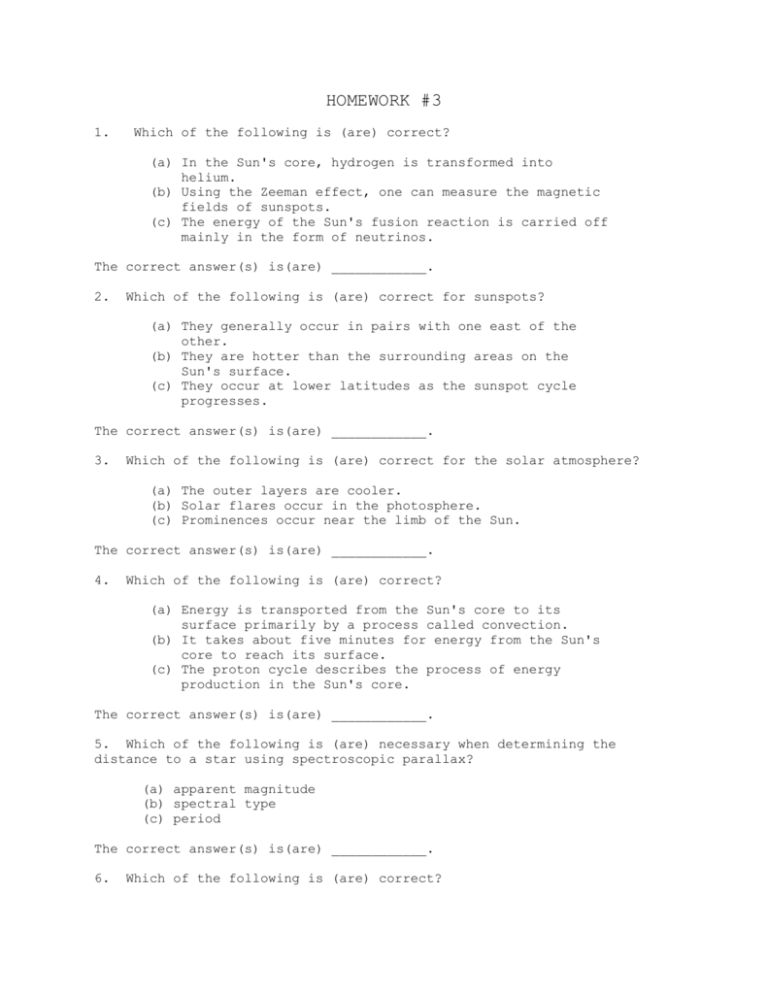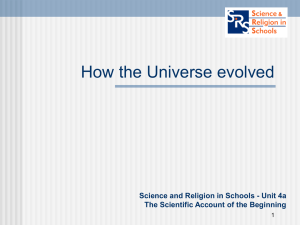Homework #3, AST 1002.doc
advertisement

HOMEWORK #3 1. Which of the following is (are) correct? (a) In the Sun's core, hydrogen is transformed into helium. (b) Using the Zeeman effect, one can measure the magnetic fields of sunspots. (c) The energy of the Sun's fusion reaction is carried off mainly in the form of neutrinos. The correct answer(s) is(are) ____________. 2. Which of the following is (are) correct for sunspots? (a) They generally occur in pairs with one east of the other. (b) They are hotter than the surrounding areas on the Sun's surface. (c) They occur at lower latitudes as the sunspot cycle progresses. The correct answer(s) is(are) ____________. 3. Which of the following is (are) correct for the solar atmosphere? (a) The outer layers are cooler. (b) Solar flares occur in the photosphere. (c) Prominences occur near the limb of the Sun. The correct answer(s) is(are) ____________. 4. Which of the following is (are) correct? (a) Energy is transported from the Sun's core to its surface primarily by a process called convection. (b) It takes about five minutes for energy from the Sun's core to reach its surface. (c) The proton cycle describes the process of energy production in the Sun's core. The correct answer(s) is(are) ____________. 5. Which of the following is (are) necessary when determining the distance to a star using spectroscopic parallax? (a) apparent magnitude (b) spectral type (c) period The correct answer(s) is(are) ____________. 6. Which of the following is (are) correct? (a) If I triple the distance to a star it will look eighty one times fainter. (b) Spectral class A stars have stronger absorption lines than those with spectral class O. (c) The luminosity class of a star is a measure of the ionization in its atmosphere. The correct answer(s) is(are) ____________. 7. Which of the following is (are) correct? (a) The primary source of the Sun's energy is meteorite infall. (b) A stellar spectrum visible from the Earth is an absorption spectrum. (c) The H and R in the term, "HR Diagram", stand for Helmholtz and Roberts. The correct answer(s) is(are) ____________. 8. Which of the following is (are) correct? (a) If one star is five magnitudes greater than another star, it is 100 times fainter than that second star. (b) The absolute magnitude is the apparent magnitude that a star would have at a distance of 1000 parsec. (c) Comets have very elliptical orbits. The correct answer(s) is(are) ____________. 9. Which of the following is (are) correct? (a) Massive stars evolve more quickly. (b) Protostars are larger than normal stars. (c) A spectral type F star is cooler than one of spectral type G. The correct answer(s) is(are) ____________. 10. Which of the following is (are) correct? (a) The primary reaction in the sun's core is a fission reaction. (b) "Limb Darkening" occurs in the Sun's photosphere. (c) Plages and flares on the surface of the sun are the same phenomenon. The correct answer(s) is(are) ____________. 11. Which of the following is (are) correct? (a) Magnetic storms occur on the Earth when the sun is near sunspot maximum. (b) If the stellar parallax of a star is .1 arc sec the distance to it is 100 parsecs. (c) Mercury always keeps the same face toward the Sun. The correct answer(s) is(are) ____________. 12. Which of the following is (are) correct? (a) The surface of Venus is hot due to the "greenhouse effect". (b) Venus is brightest in gibbous phase. (c) Venus rotates from east to west. 13. Which of the following is (are) correct? (a) Olympus Mons is a large canyon on Mars. (b) The seasons on Mars are more severe in the southern hemishphere. (c) Mars red color is caused by the oxidation of iron (rust). The correct answer(s) is(are) ____________. 14. Which of the following is (are) correct? (a) The Kuiper belt and the Oort cloud are really the same thing. (b) Comets contain a lot of water. (c) Comets and asteroids are made largely of the same materials. The correct answer(s) is(are) ____________. 15. Which of the following is (are) characteristic of Cepheid variables? (a) Their absolute magnitude depends on their period. (b) They are found in the galactic plane. (c) They pulse with periods of about one day or less. The correct answer(s) is(are) ____________. 16. Which of the following is (are) correct? (a) White dwarfs contain a super conducting material. (b) Uranium is produced in red giant stars. (c) The triple alpha process occurs in main sequence stars. The correct answer(s) is(are) ____________. 17. Which of the following is (are) correct? (a) Reddening (color excess) in a star's spectrum is primarily caused by interstellar dust. (b) One needs to know a star's size in order to determine its color excess. (c) HI regions emit 21-cm. wavelength radiation. The correct answer(s) is(are) ____________. 18. Which of the following is (are) correct? (a) If the turnoff point is low on the main sequence in the color-magnitude diagram of a star cluster, the cluster is old. (b) Emission nebulae are referred to as HII regions. (c) The reactions in the cores of stars are exothermic. The correct answer(s) is(are) ____________. 19. Which of the following is (are) correct? (a) The color index of a cool red star is a positive number. (b) The sun was located at the center of the "Kapteyn" universe. (c) Elements heavier than iron are produced in supernovae. The correct answer(s) is(are) ____________. 20. Which of the following is (are) correct for black holes? (a) Electromagnetic waves slow down as they recede (move away) from the event horizon. (b) An observer falling into a black hole would notice that his clock slowed down. (c) The event horizon is defined by the Schwarzschild radius. The correct answer(s) is(are) ____________. 21. Which of the following is (are) correct? (a) All pulsars are neutron stars. (b) Pulsars pulse at a very constant rate. (c) The Crab pulsar has a period of less than one second. The correct answer(s) is(are) ____________. 22. Which of the following is (are) correct? (a) Binary neutron stars are thought to emit gravity waves. (b) Synchrotron radiation comes from particles traveling slowly with respect to the speed of light. (c) Type II Cepheid variable stars are Population II stars. The correct answer(s) is(are) ____________. 23. Which of the following is (are) correct? (a) HII regions contain cold molecular hydrogen. (b) An absorption nebula is an HI region. (c) RR-Lyra stars frequently occur in globular clusters. The correct answer(s) is(are) ____________. 24. Which of the following is (are) correct? (a) All cool stars are smaller than all hot stars. (b) Spiral galaxies have more angular momentum than ellipticals. (c) All white dwarf stars are older than all main sequence stars. The correct answer(s) is(are) ____________. 25. Which of the following is (are) correct? (a) Type II supernovae occur in binary systems. (b) The period-luminosity relationship is valid only for main sequence stars. (c) The helium flash occurs after a star evolves off of the main sequence. The correct answer(s) is(are) ____________. 26. Which of the following is (are) correct? (a) Normal galaxies radiate primarily by synchrotron radiation. (b) Supernovae can occur only once in a given star. (c) Spiral arms in a galaxy are thought to be density waves. The correct answer(s) is(are) ____________. 27. Which of the following is (are) correct? (a) The Milky Way is a spiral galaxy. (b) We say there is "missing mass" in galaxies because we can't see enough material to explain the gravity that appears to hold them together. (c) Seyfert galaxies emit spectra having broad emission lines. The correct answer(s) is(are) ____________. 28. If Hubble's constant is 50 km/sec/Mpc, an object receding from us at the rate of 5000 km/sec would be _____ away. The correct answer(s) is(are) ____________. 29. Which of the following is (are) correct? (a) A galactic cluster is a cluster of galaxies. (b) The Sun is located in the halo of the Milky Way Galaxy. (c) BL Lacertae galaxies are active galaxies. The correct answer(s) is(are) ____________. 30. Which of the following is (are) correct? (a) T Tauri stars lie in the instability strip of the HR diagram. (b) A globular cluster contains up to 100,000 stars. (c) The Tully-Fischer relation uses the rotation of a galaxy to determine its distance. The correct answer(s) is(are) ____________. 31. "The Universe looks the same in all directions from all points in space". This statement is called _________________. (1) (2) (3) (4) (5) the the the the the cosmological principle perfect cosmological principle Russell-Vogt theorem homogeneous space principle Great Society 32. Which of the following is (are) important in the determination of the size of the Universe? (a) All objects at great distances show red shifted spectra. (b) The radius of the event horizon of a black hole is given by the expression R = 3M. (c) The Chandrasekhar limit. The correct answer(s) is(are) ____________. 33. Which of the following is (are) correct? (a) The cosmological redshift is caused by the expansion of space. (b) The larger the Hubble constant (H) is, the older the Universe. (c) The 3 degree background radiation arose at the time of inflation in the early universe. The correct answer(s) is(are) ____________. 34. Which of the following pertain(s) to the term "decoupling" in the "Big Bang" cosmology? (a) When light breaks free from the event horizon in a black hole. (b) When photons no longer scattered off of electrons which had attached themselves to ions to form neutral atoms. (c) When the universe became transparent to neutrinos. The correct answer(s) is(are) ____________. 35. Which of the following is (are) correct? (a) A spherical space is negatively curved. (b) Since we observe all deep space objects to be receding from us in all directions, we can conclude that we are at the center of the Universe. (c) The anthropic principle states that the fine-tuned nature of the Universe suggests that it was fashioned so that humans can exist. The correct answer(s) is(are) ____________. 36. Which of the following pertain to inflation of the early Universe? (a) It was a hyper-light speed expansion of space in the early universe. (b) It was proposed to explain why the microwave background (3K radiation) is so uniform. (c) It was used to explain the irregularities in the cosmic background radiation. The correct answer(s) is(are) ____________. 37. Presuming that the initial stars all had identical mass, list the ages of the following stars in chronological order (starting with the youngest)? (a) (b) (c) (d) protostar Cepheid variable main sequence star red giant star The correct answer(s) is(are) ____________. 38. Which of the following best states the Russell-Vogt theorem? (a) Fundamental proton-proton chain fusion reactions yield neutrinos. (b) The ultimate result of a protostar collapse is uniquely determined by its mass and composition. (c) Gravitational radiation is emitted by massive revolving bodies. (d) Supernovae occur only in stars having mass greater than eight solar masses. The correct answer(s) is(are) ____________.









